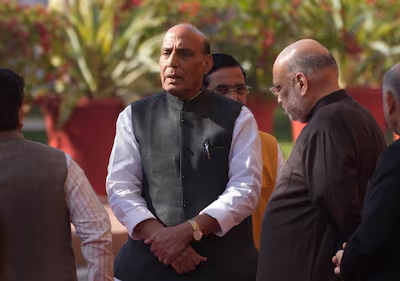The recent hand-to-hand brawl between Indian and Chinese soldiers has brought the Asian nuclear powers' festering border dispute back into focus, more than two years after the countries mobilised tens of thousands of troops following deadly clashes.
On Monday, Indian Defence Minister Rajnath Singh again accused China of attempting to unilaterally “change the status quo”, with Chinese People's Liberation Army alleging Indian forces had crossed the unmarked de facto Himalayan border.
Mr Singh told the Indian Parliament that the Chinese troops tried to enter the Yangtze region in Tawang Sector in Arunachal Pradesh in remote north-eastern India on December 9.
The soldiers of both sides reportedly fought with sticks and canes, with some suffering “minor injuries”.
It was the most serious clash on the disputed border since 2020 when the rival armies attacked each other with iron rods and clubs in Ladakh’s Galwan Valley along the undemarcated border — the Line of Actual Control.
India said 20 of its soldiers were killed in the latest clashes, while Beijing claimed four of its troops died.
What is the reason for the border dispute?
India and China share a nearly 4,000km undemarcated border known as Line of Actual Control (LAC). It traverses the mighty Himalayas and abuts Tibet and Xinjiang on the Chinese side, and Ladakh, Arunachal Pradesh and Sikkim states on the Indian side.
Arunachal Pradesh has been historically claimed by China as part of Tibet region. Last December, Beijing had renamed 15 places in the state.
The countries fought a deadly war over the disputed border in 1962, with Beijing briefly capturing parts of Arunachal Pradesh before unilaterally withdrawing its troops at the end of the conflict.
But the countries managed the border dispute in the coming decades except occasional clashes in late 60s before the 2020 fracas almost brought the countries to a brink of war.
The rival armies also clashed at Naku La area of North Sikkim last January.
In September last year, China accused India of firing shots at its troops, with New Delhi making similar allegations against Beijing.
A 1996 agreement prohibited the use of guns and explosives near the border.
How are Chinese-Indian relations?
The nuclear-powered nations have attempted to peacefully resolve the border disputes but diplomatic relations have remained strained since the Galwan incident in 2020, particularly due to the growing political tension between Indian Prime Minister Narendra Modi and his Chinese counterpart Xi Jinping.

Both countries held 16 rounds of a “frank” and “in-depth” exchange of views to resolve the dispute and agreed to disengage from contentious points.
While the troops completed disengagement from a key area in the disputed Eastern Ladakh region in September, many other potential flashpoints remain undisputed.
The Chinese forces continue to block access to traditional patrolling areas of the Indian military in the Depsang Plains and Charding Nala regions on the LAC.
Depsang Plains is a plateau at an altitude of 4,800m. Chinese troops are allegedly occupying an 18km area which India considers its own territory.
Beijing has consistently refused to accept those areas are Indian territory.
What was the response?
New Delhi has been aggressively enhancing its infrastructure along the border.
It opened the world's highest driveable road, a 52km stretch in Chisumle-Demchok to allow its troops faster access to the cold, rugged terrain last December.
It has also kick-started an extensive development campaign in the remote region to match Chinese military investment across the LAC, further irking Beijing.
Experts say India must deliver a considered response in the absence of bilateral talks to resolve the dispute.
“It was a relatively low-key level and once the Indian side responded they went back, but the second aspect is that this is an indication for escalation and can be repeated," Srikanth Kondapalli, professor of Chinese studies at New Delhi's Jawaharlal Nehru University, told The National.
“India needs a more concentrated response — political, diplomatic and military.”





